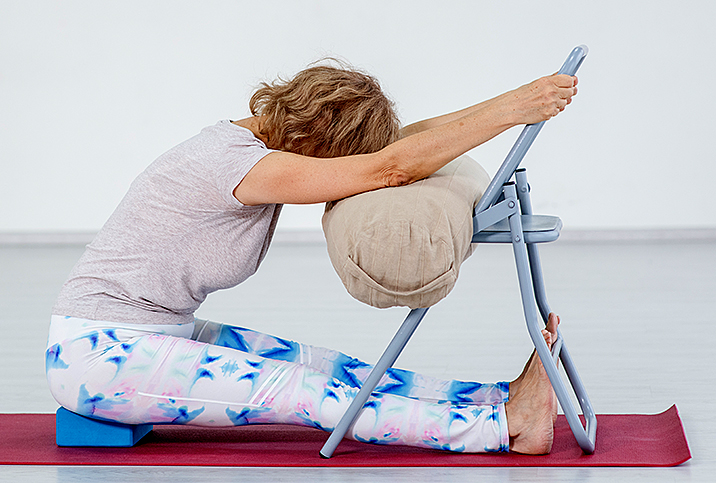The Annual Exam You Didn't Know You Needed

I was surprised during my recent interview with pelvic floor trainer Kim Vopni when she said women should see a pelvic floor physical therapist (PFPT) annually. I had never heard this recommended before.
As if on cue, I experienced my first concerning pelvic floor symptom: a feeling of fullness, as if a tampon wasn't in the right place. I had no pain and nothing felt amiss when I felt with my finger, but something was different and it wasn't going away.
I called Vitality Physical Therapy and spoke with the owner, Lori O'Neill, P.T., D.P.T. She has been helping women and their pelvic floors for 25 years, and she encouraged me to make an appointment.
Why is pelvic floor health important?
The pelvic floor is a mesh of muscles that form a bowl at the base of the torso to support the pelvic organs: the bladder and intestines for everyone, and the uterus and vagina in some.
The two most common pelvic floor disorders (PFD) are:
- Prolapse: When the pelvic organs press into the vagina.
- Incontinence: When there is an involuntary leaking of urine.
PFD symptoms can be uncomfortable, painful or embarrassing. They can cause you to limit your physical activity and your social life—and they can make intimacy awkward.
"Have we normalized leaking?" asked Jill Rabin, M.D., a urogynecologist at LIJ/Northwell and co-author of "Mind Over Bladder."
"My interest is in making sure people know they can at least reduce, if not eliminate, their leakage. Getting a diagnosis and creating a treatment plan with your physician is the key to pelvic floor health," she said.
What happens at a 'wellness' pelvic floor exam?
At my appointment, O'Neill began by assessing the alignment and joint mobility of my pelvic bones, hips and lumbar spine. Childbirth or other traumatic events can misalign the joints of the pelvis and create problems with the pelvic floor. She then asked me to lift my shoulders off the table so she could check my abdominal wall for strength and diastasis recti separation.
O'Neill's table didn't have stirrups; instead, she placed pillows under my knees as I relaxed in the butterfly position with a sheet and blanket covering my body. The next step was a vulvar dermatology screening.
There was no scooting to the edge of the table while a spotlight shone on me. With O'Neill's gentleness and the positioning of the blankets, this close visual exam didn't feel exposing at all. She checked for the condition of the skin: color, dryness, scars from birthing and any signs of any abnormality.
Since I had a C-section, she examined the scar to be sure it had healed without adhesions, which can cause mobility or organ placement issues. She then slowly moved her fingers around inside, occasionally asking me to cough, lift my shoulders off the table or squeeze her finger with a variety of Kegels while she assessed my pelvic floor muscles.
She later told me she was checking:
- Pelvic floor muscles for strength, endurance, range of motion, coordination and their ability to automatically activate with core stability
- Pelvic organs for motility, mobility, fascia and ligament support, and prolapse
- Myofascial mobility
- Pelvic nerve sensitivity
Since I was concerned about a prolapse, she also assessed me internally while I was standing. Somehow, it wasn't nearly as awkward as it sounds.
O'Neill asked questions to assess any bladder and intimacy concerns. She showed me how to engage my core for stability and coordination while moving, and gave me handouts explaining her recommendations for how I can keep my pelvic floor functioning properly.
When do you need to start seeing a PFPT?
O'Neill works with patients in every life stage: pre-conception, prenatal, postpartum, perimenopause, menopause or gender transitioning.
In several European countries, most notably in France, PFPT is standard care with the birth of a child. Not so much in America or Canada.
"One of the most impactful times to work with a PFPT for preventive care is during the prenatal period. PFPTs that are experienced in pregnancy-related rehab (not all are) have expert biomechanical knowledge of pregnancy, birth and postpartum healing," O'Neill said. "Prenatally, a PFPT can identify and reduce physical limitations that could impair a birth process or cause unnecessary strain to the pelvic structures. This not only improves immediate postpartum healing, but also sets the stage for optimal long-term pelvic health."
Do you need to see a PFPT annually?
To counter the effects of childbirth, being overweight and gravity, some professionals recommend women see a PFPT yearly to learn how to care for this part of their body and diagnose problems early.
"The focus of PFPT is to optimize pelvic area wellness. Ideally, this is a proactive approach to prevent or minimize dysfunction and pain through individualized patient education and screening for issues throughout a lifetime, much like a semiannual dental exam," O'Neill explained.
Rabin disagreed. She believes screening should be done at an annual well-woman exam with a gynecologist, and a PFPT should only be utilized when there is a specific need.
Most importantly, Rabin wants everyone to do Kegels. "It's really important to teach Kegels to young women (even beginning in high school), and just doing that may help keep pelvic floor strength at its best," she said. "But if you are having trouble doing these correctly or aren't motivated to do the exercises on your own, you can see a physical therapist to help you."
In my three decades of well-woman exams, I don't know if my doctor or midwife ever assessed my pelvic floor, and if they did, they didn't discuss it with me. At my PFPT appointment, I learned I don't have a prolapse, but I do have an area in my vaginal wall that is weak, which would explain the sensation of fullness I felt. I have learned to do Kegels daily and no longer have symptoms.
Seeing a PFPT every year might not be necessary, but I now see the value in strategic appointments (such as around births and marathon training), and plan to see O'Neill annually until I am safely on the other side of menopause.


















